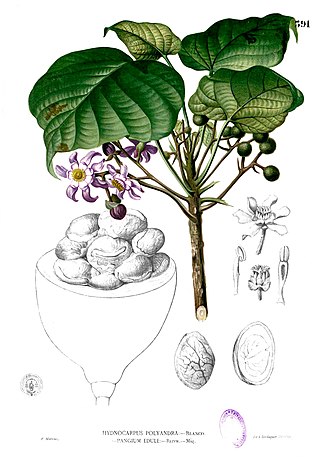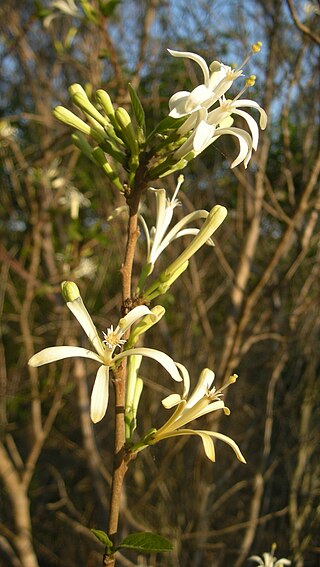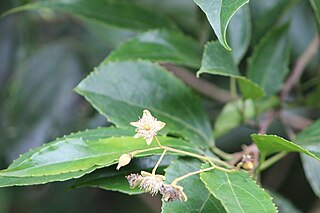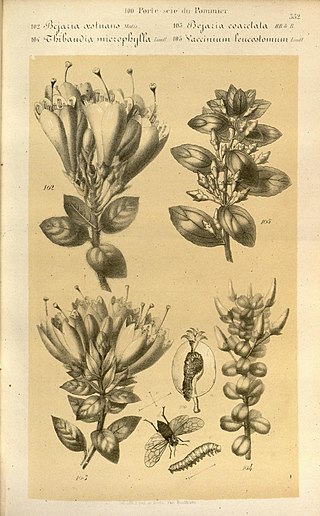
Joseph Marie Henry Alfred Perrier de la Bâthie was a French botanist who specialized in the plants of Madagascar.

Achariaceae is a family of flowering plants consisting of 31 genera and about 155 species of tropical herbs, shrubs, and trees. The APG IV system has greatly expanded the scope of the family by including many genera previously classified in Flacourtiaceae. Molecular data strongly support the inclusion of this family in the order Malpighiales.
Thomas Gordon Hartley was an American botanist.

Turraea is a genus of plants in the family Meliaceae, native to the Old World tropics and subtropics.
Sacleuxia is a genus of flowering plants in the family Apocynaceae. It is also in the Periplocoideae subfamily.

Macrohasseltia is a monotypic genus of flowering plants in the family Salicaceae. It consists of one species of tree: Macrohasseltia macroterantha, which is native to Central America. Formerly placed in the heterogeneous family Flacourtiaceae, Macrohasseltia is now classified in Salicaceae, along with close relatives Bennettiodendron, Carrierea, Idesia, Itoa, Olmediella, Poliothyrsis, and even the willows (Salix) and cottonwoods (Populus) themselves.
Ahernia is a genus of a single species, Ahernia glandulosa, a tree in the family Achariaceae, native to Hainan and Luzon island of the Philippines. Previously it was treated in the family Flacourtiaceae before being placed in Achariaceae. Ahernia is closely related to the American genera Hasseltia, Macrothumia, and Pleuranthodendron, but differs in its axillary racemes and more numerous (10–15) petals. Ahernia glandulosa is found in low elevation primary forests and is known in the Tagalog language as butun or sanglai. It grows 8–15 m (26–49 ft) tall.
Ophiobotrys zenkeri is a species of flowering plant in the family Salicaceae. It is a tree native to tropical Africa from Ivory Coast to Gabon and is the only member of the genus Ophiobotrys. Formerly classified in the Flacourtiaceae, phylogenetic analyses based on DNA data indicate that this species, along with its close relatives in the Asian genera Osmelia and Pseudosmelia, are better placed in a broadly circumscribed Salicaceae. Ophiobotrys differs from its close relatives in having 5 sepals, 5(-6) stamens, one divided style, and terminal inflorescences.

Macrothumia is a genus in the willow family Salicaceae with a single species Macrothumia kuhlmannii. It is a tree native to the states of Bahia, Espírito Santo, and Minas Gerais in Brazil. Formerly classified in the genus Banara in the family Flacourtiaceae, phylogenetic analyses based on DNA data indicate that this species, along with its close relatives in Ahernia, Hasseltia, and Pleuranthodendron are better placed in a broadly circumscribed Salicaceae. Macrothumia differs from its close relatives in having a congested fascicle- or umbel-like inflorescence and a large fruit. The genus name is derived from the Greek word μακροθυμία, which means long-suffering and enduring patience.
Hecatostemon completus is a species of shrub or tree native to northeastern South America and is the only member of the genus Hecatostemon.
Loheria is a genus of flowering plants belonging to the family Primulaceae.
Themistoclesia is a genus of flowering plants belonging to the family Ericaceae.

Harmandia mekongensis is a species of flowering plants. It is the only species in the monotypic genus of Harmandia. In the APG IV system, the genus is placed in the family Olacaceae. Other sources place it in the segregate family Aptandraceae.

Demosthenesia is a genus of flowering plants belonging to the family Ericaceae.
Pellegrinia is a genus of flowering plants belonging to the family Ericaceae.
Mappianthus is a genus of flowering plants belonging to the family Icacinaceae.
Hartleya is a monotypic genus of flowering plants belonging to the family Stemonuraceae. The only species is Hartleya inopinata.
Humbertioturraea is a genus of flowering plants belonging to the family Meliaceae.
Merrilliodendron is a monotypic genus of flowering plants belonging to the family Icacinaceae. It has a synonym of PeekeliodendronSleumer. The only species is Merrilliodendron megacarpum(Hemsl.) Sleumer
Peterodendron is a monotypic genus of flowering plants belonging to the family Achariaceae. The only species is Peterodendron ovatum.






